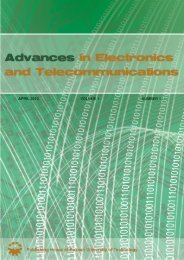november 2010 volume 1 number 2 - Advances in Electronics and ...
november 2010 volume 1 number 2 - Advances in Electronics and ...
november 2010 volume 1 number 2 - Advances in Electronics and ...
You also want an ePaper? Increase the reach of your titles
YUMPU automatically turns print PDFs into web optimized ePapers that Google loves.
34 ADVANCES IN ELECTRONICS AND TELECOMMUNICATIONS, VOL. 1, NO. 2, NOVEMBER <strong>2010</strong><br />
Fig. 4. Results chart for 20% traffic switched every 20 seconds.<br />
Fig. 5. Results chart for 20% traffic switched every 40 seconds.<br />
(different delays on different paths). Further considerations<br />
gave several <strong>in</strong>terest<strong>in</strong>g answers on the mean<strong>in</strong>g of dynamic<br />
rout<strong>in</strong>g mechanisms. The proposed simulation model made it<br />
possible to answer some questions <strong>and</strong> to shed light on the<br />
scope of other problems. Us<strong>in</strong>g some proportions between<br />
classes <strong>in</strong> differentiated services doma<strong>in</strong> packets reorder<strong>in</strong>g<br />
caused by path switch<strong>in</strong>g should be marked <strong>in</strong> end-to-end<br />
balance. It may not be skipped <strong>and</strong> omitted <strong>in</strong> the system<br />
analysis. The AF switched sequence changed order packets to<br />
all AF sendpacketsratiomaynotbeexpla<strong>in</strong>edbyapply<strong>in</strong>gthe<br />
known analytical equations (for the non-preemptive priority<br />
system). The ratio value is significant for flexible services <strong>and</strong><br />
should be taken <strong>in</strong>to consideration. Furthermore, an important<br />
conclusion for EF traffic was found. The stream<strong>in</strong>g services<br />
have lower switched sequence changed order than all EF sent<br />
packets ratio when EF share <strong>in</strong> the overall traffic amount<br />
is 20–40 %. Some additional remarks were also found for<br />
different time values between rout<strong>in</strong>g table recalculations. It<br />
turned out that the optimal time between rout<strong>in</strong>g table updates<br />
(<strong>in</strong> short term changes – seconds) was 35–40 seconds <strong>in</strong>terval.<br />
This statement is based on simulation results but will not be<br />
discussed <strong>in</strong> this paper due to space limitation. For rout<strong>in</strong>g<br />
table switch<strong>in</strong>g time a local m<strong>in</strong>imum of the 35–40 seconds<br />
was observed. For all analyzed situations residual time is<br />
important when packet length differs between given traffic<br />
classes (EF – 160 bytes, AF – 500 bytes, BE – 1,500 bytes).<br />
Further <strong>in</strong>vestigationswill be aimed at f<strong>in</strong>d<strong>in</strong>gthe relationsfor<br />
AF traffic <strong>and</strong> expla<strong>in</strong><strong>in</strong>g the issue us<strong>in</strong>g the newly developed<br />
analytical equations.<br />
REFERENCES<br />
[1] S. Chen <strong>and</strong> K. Nahrstedt, “An Overview – of – Service Rout<strong>in</strong>g for the<br />
Next Generation High – Speed Networks: Problems <strong>and</strong> Solutions,” IEEE<br />
Network Magaz<strong>in</strong>e, vol. 12, no. 6, pp. 64–79, Dec. 1998.<br />
[2] G. Feng, K. Makki, N. Piss<strong>in</strong>ou, <strong>and</strong> C. Douligeris, “Heuristic <strong>and</strong> Exact<br />
Algorithms for QoS Rout<strong>in</strong>g with Multiple Constra<strong>in</strong>ts,” IEICE Trans.<br />
Commun., no. 12, pp. 2838–2850, Dec. 2002.<br />
[3] J. T. Moy, OSPF Anatomy of an Internet Rout<strong>in</strong>g Protocol, 2001.<br />
[4] ——, OSPF Complete Implementation, 2001.<br />
[5] J. N. Daigle, Queu<strong>in</strong>g Theory with Applications to Packet Telecommunication,<br />
2005.<br />
[6] [onl<strong>in</strong>e], http://www.omnetpp.org.<br />
M. Czarkowski received the M.Sc. degree <strong>in</strong> telecommunication systems<br />
from Gdansk University of Technology (GUT), Gdansk, Pol<strong>and</strong>, <strong>in</strong> July<br />
2004. He is currently pursu<strong>in</strong>g for the Ph.D. degree <strong>in</strong> Telecommunication<br />
Networks <strong>and</strong> Systems, GUT. His Ph.D. work focuses ma<strong>in</strong>ly on dynamic<br />
rout<strong>in</strong>g algorithms with Quality of Service (QoS.)<br />
S. Kaczmarek received the M.Sc./B.Sc. <strong>in</strong> electronics eng<strong>in</strong>eer<strong>in</strong>g, Ph.D<br />
<strong>and</strong> D.Sc <strong>in</strong> switch<strong>in</strong>g <strong>and</strong> teletraffic science from Gdansk University of<br />
Technology, Gdansk, Pol<strong>and</strong>, <strong>in</strong> 1972, 1981 <strong>and</strong> 1994, respectively. His<br />
research <strong>in</strong>terests <strong>in</strong>clude: IP QoS <strong>and</strong> GMPLS networks, switch<strong>in</strong>g, rout<strong>in</strong>g,<br />
teletraffic <strong>and</strong> quality of service. He has published more than 190 papers.<br />
Now he is the Head of Tele<strong>in</strong>formation Networks Department.







